1820-1861 The Dukes of Bedford
Bedford House, on the Bury Road, boasts a rich history having been built in the 1820s as part of the Bedford Lodge Estate by Francis Russell, 7th Duke of Bedford, born on 13 May 1788 to John Russell, the 6th Duke of Bedford and his wife the Honourable Georgiana Byng, daughter of the Viscount Torrington. Bedford Lodge, now the Bedford Lodge Hotel, was built in 1820 for John Russell, the 6th Duke of Bedford, with Bedford House and Stables, along with Bedford Cottage, which is now called Rockfield House, added a short while later by the 7th Duke of Bedford. Francis was educated at Westminster School and Trinity College, Cambridge before becoming MP for Peterborough. Within 3 years he represented Bedfordshire, later taking his place in the House of Lords. He married the Honourable Anna Maria Stanhope, daughter of the Earl of Harrington, on 8th August 1808 and they had a son, William who succeeded him on his death on 14th May 1861, 73 years and one day after he was born. In 1840 Admiral Rous, 'perpetual president of the Jockey Club' was appointed by the Duke to oversee his stud, stables and become private handicapper, a post which he held for 20 years. It must have been ironic for Rous when his great rival in the Jockey Club, Sir Joseph Hawley, bought the Bedford Lodge Estate. During the time he resided at Bedford House he employed William Edwards to train his horses at 'the Palace' and William Butler junior as his trainer at Bedford House.
1822-April 1844 Robert Pettit
Robert Pettit, born at Newmarket St Mary and baptised at St Mary's on 3 June 1795, was apprenticed to James Edwards, although he spent a short period in India before returning to Newmarket to set up as a public trainer. By 1822 he was running horses in his own colours, and within a few years was sending out Classic winners. He prepared Zoe for Mr Arthur Molony to win the 1828 1000 Guineas when partnered by Jem Robinson, while 2 years later Variation won the 1830 Oaks for Mr W Scott Stonehewer when ridden by George Edwards. In December 1833 Sir Sandford Graham removed his horses from Pettit, employing his head lad to train them elsewhere. Pettit was left with only a small string, but things improved rapidly and he soon acquired other owners, principally Thomas Thornhill. He trained Extempore for Thomas Thornhill to win a further 1000 Guineas in 1843, with Sam Chifney on board. Other winners over the years included four July Stakes, three consecutive Gold Cup Vases, the 1828 Ascot Gold Cup, and St Francis won the Gold Cup in 1840 in Mr Pettit's own colours. In January 1844 he was in financial difficulties, and soon afterwards Thomas Thornhill removed his eight horses from Pettit to Sam Chifney. In April 1844 the superb house and yard, described as the most extensive and complete racing establishment in Newmarket on Bury Road were bought by the Duke of Bedford and became better known as Bedford House.
1828 1000 Guineas at Newmarket ZOE (SR 1923) 6/5 fav owned by Arthur Molony, trained by Robert Pettit and ridden by Jem Robinson
1828 Ascot Gold Cup BOBADILLA 8/1 owned by Arthur Molony, trained by Robert Pettit and ridden by Jem Robinson
1830 Epsom Oaks VARIATION (SR 1782) 28/1 owned by W Scott Stonehewer, trained by Robert Pettit and ridden by George Edwards
1840 Ascot Gold Cup ST FRANCIS 5/2 fav owned and trained by Robert Pettit and ridden by Sam Chifney jnr
1840 Ascot Gold Vase ST FRANCIS 2/1 owned and trained by Robert Pettit and ridden by Jem Robinson
1841 Ascot Gold Vase SATIRIST 2/1 owned and trained by Robert Pettit and ridden by Nat Flatman
1842 Ascot Gold Vase ST FRANCIS 4/1 owned and trained by Robert Pettit and ridden by Jem Robinson
1843 1000 Guineas at Newmarket EXTEMPORE (SR 1816) 7/1 owned by Thomas Thornhill, trained by Robert Pettit and ridden by Sam Chifney jnr
June 1845-Autumn 1863 William Butler junior
William Butler, born in Newmarket in 1815, came from a racing family, his father William being trainer to the Duke of York, his mother being the former Sarah Chifney, and his brother being crack jockey Frank Butler. Although William enjoyed a few rides, he was always destined to excel as a trainer. He launched his training career in 1840, training for Mr Lupin, basing himself at the family-owned Nunnery Stables. In June 1845 he was appointed private trainer to the Duke of Bedford at Bedford House, and enjoyed considerable success during his time there. He won the 1844 1000 Guineas with Sorella prior to his move to Bedford House, but once he was settled in his new premises he won the 1855 1000 Guineas for a second time with Habena. He helped the Duke of Bedford become leading owner in 1856 when his 13 horses won 42 races, and continued to be successful right up to the time of the Duke's death in 1861, training in excess of 650 winners. The Duke had discussed what should happen to Bedford House in the event of his death and, helped by Sir Joseph Hawley, Bedford House passed into William Butler's hands for 3,900 guineas, the adjoining twenty acres of paddocks being sold to Sir Williamson Booth for 3,000 guineas. He continued at Bedford House with Lord Stamford's horses, but in 1864 Lord Stamford went into partnership with Captain John White, and all their horses and Butler went to Heath House for a short period from 1864, after Joseph Dawson left, until 1865. William Butler sold Bedford House for £5,000 in Autumn 1863 to Captain Machell, who installed George Bloss as his trainer. William Butler was a coursing enthusiast. After retiring from the Turf he bred and raced greyhounds with considerable success from the kennels of his substantial freehold Waterloo Lodge. He died there on 22 January 1874 aged 59 after a short attack of bronchitis.
1844 1000 Guineas SORELLA (SR 1904) 10/1 owned by George Osbaldeston, trained by William Butler jnr and ridden by Jem Robinson
1855 1000 Guineas HABENA (SR 1956) evens fav owned by 7th Duke of Bedford, trained by William Butler jnr and ridden by Sam Rogers
For over 4 centuries racing has been staged in Newmarket, but how have the racecourses evolved from an initial starting point at Fleam Dyke Pumping Station, some 8 miles from the town, with a winning post barely 200 metres from the town centre, into two world recognized, excellent racecourses and a universal acceptance that Newmarket is the Headquarters of racing?
To access an interactive racecourse map showing over 50 individually named racecourses CLICK HERE. The map will enable you to:-
1. Determine when extended races over 8 miles, 6 miles and 4 miles began to be replaced by the courses now visited by thousands annually;
2. Consider how the challenge of crossing the Devil's Dyke was overcome;
3. Contemplate why the town no longer has a steeplechase course despite having at least 5 courses during the past 2 centuries;
4. Examine the practicalities of having up to 48 starting posts and winning posts;
5. Appreciate that it was not financially viable to have an open racecourse spread widely across the heath, with a finishing post barely 200 metres from the town centre;
6. Research how and why the Cambridgeshire Handicap has been contested over 3 different courses.
NOTE: The map does not make mention of 2 particular courses:-
(i) Sefton Course (also known as the Cambridge Road Course)
Source: 1970 Raceform. Used from 1959 to 1975.
(ii) New Circular Course
The Circular Handicap was run on Friday 29th October 1875 on the New Circular Course of about two miles.
Source: London Standard (30th October 1875): ''the horses started near the Turn of the Lands, ran back way of the Cambridgeshire Course towards the Ditch, and afterwards proceeded down the side of the Tan Gallop, and turned into the Rowley Mile near the Bretby Stakes starting post, finishing at the stand at the end of the flat. Except in the hollow near the Cambridgeshire start the runners should have been visible all the way if the sky had been bright and clear''.
Another report hoped that the Circular Handicap would become a feature in future programmes, as it would be contested in front of the new grandstand which would be completed in about a year and would be able to accommodate thousands.
(I am grateful to Tim Cox for bringing attention to these 2 courses.)
Enjoy researching the intriguing history of Newmarket and its many racecourses.
1861-1863 Sir Joseph Hawley
After his death in May 1861 the Bedford Estate was purchased by Sir Joseph Henry Hawley, born on 27th October 1813 who was a renowned and successful racehorse owner and breeder. He began training at Fyfield in Wiltshire, sending out 3 Derby winners prior to acquiring the Bedford Estate. In 1851 he owned Teddington (SR 2046) who won the Derby by 2 lengths from Marlborough Buck when ridden by Job Marson. In 1858 he owned and bred Beadsman (SR 2017) who landed the Epsom Derby by a length from Toxophilite in the hands of his regular jockey John Wells, and the very next year he completed consecutive Derby wins with Musjid (SR 2000), winning by half a length from Marionette when once again ridden by John Wells. However, it was while he was associated with the Bedford Estate that he sent out Blue Gown (SR 2042) in the hands of John Wells to win the Derby in 1858, beating King Alfred by half a length. His crowning glory during his period of association with Bedford House was winning the 1869 St Leger with Pero Gomez (SR 2005) ridden by John Wells, beating Martyrdom by a neck, fulfilling his long held ambition to win all 5 English Classics.
1862 Ascot Gold Cup ASTEROID owned by Sir Joseph Hawley and ridden by John Wells

1861-1864 William Butler
Having purchased the Bedford Lodge Estate in 1861 Sir Joseph Hawley sold Bedford Lodge to the Duke's racehorse trainer William Butler. Butler made significant changes to the Estate, separating Bedford Lodge, the Bedford House Stables and Bedford Cottage. He demolished Bedford Lodge stables soon after purchasing them in 1861, and sold the Lodge to Joe Dawson in 1864 for £6,500. Dawson spent the next 3 years extending the stables which are the present day Highfield Stables. Meanwhile, he sold Bedford House and Bedford Cottage Stables to Captain J Machell in November 1863 for £5,000.
1863-1872 Captain James Machell, Henry Chaplin & George Bloss
Captain James Octavius Machell, who was born at Etton Rectory near Beverley in Yorkshire on 5th December 1837, was educated at Rossall School in Lancashire before joining the army. After his posting to India he returned to the United Kingdom and was sent to The Curragh where he combined his army career with training horses. He was so successful that he captured the leading trainer title in Ireland in 1862. This success encouraged him to consider whether to continue to pursue his army career and training, leading him to the decision to resign his commission and take over stables in Kennet on the outskirts of Newmarket. In 1864 he hit lucky, training the 3 year old Bacchus to land the 200 Guineas Prince of Wales's Stakes at Newmarket over 1 mile on Monday 25th April 1864, beating Count Batthyany's Suburban, Count de Lagrange's Vivid and 21 others. On the back of that victory Bacchus was quoted at 14/1 to land the 1000 Guineas later in the week, although she did not take her place in that race. However, James Machell landed such a huge gamble on the 3 year old filly that he was able to purchase Bedford Cottage Stables from William Butler, going on to hire George Bloss as his personal trainer in January 1864, a duty he shared with his brother Charles Bloss. In 1865 Machell, who was racing manager to Henry Chaplin, moved three of Chaplin's best horses, Breadalbane, Broomielaw and the yearling Hermit, to Bedford Cottage Stables. In the tradition of the day Hermit was raced as a yearling at Doncaster, having been highly tried at Newmarket over 4 furlongs on Bury Hills. In that trial he was giving 35lbs to the filly Problem, but still won by 2 lengths. On the back of that success, and as soon as the true potential of Problem was known, Jim Machell began backing Hermit for the Derby. He was at Long's Head in London and backed Hermit to win £45,000, a bet which was witnessed by the Duke of Hamilton who immediately began ribbing James Machell. He said he would lay Hermit at 30/1 for as much as James wanted, so James accepted the challenge, laying out £6000 to win £180,000 (equivalent today to about £14.5 million). Just two years later Hermit (SR 2022) won the 1867 Epsom Derby by a neck at 1000/15 in the hands of John Daley, beating Marksman (Grimshaw) and Vauban (George Fordham). After the race George Bloss revealed that he had slept in Hermit's box, on a small iron bedstead, each night for 3 months before the Derby. The iron bedstead was retained at Bedford Cottage to be shown to visitors some considerable time afterwards. Captain Machell later hired Joe Cannon, formerly private trainer to Lord Aylesford, and James Jewitt as his trainers, moving his steeplechasers to Joe Cannon at Kentford in the Forest Heath district of Suffolk.
1866 Chesterfield Cup BROOMIELAW owned by Mr H Chaplin, trained by George Bloss and ridden by Harry Custance
1867 Epsom Derby HERMIT (SR 2022) owned by Henry Chaplin, trained by George Bloss and ridden by John Daley
1868 Lincolnshire Handicap INDIGESTION owned by Sir Charles Legard, trained by George Bloss and ridden by Charles Maidment
1869 Chester Cup (Tradesmens Cup) KNIGHT OF THE GARTER owned by Lord Calthorpe, trained by George Bloss and ridden by George Fordham
1869 Chesterfield Cup VESPASIAN owned by Sir Charles Legard, trained by George Bloss and ridden by Harry Custance
1872 Wokingham Stakes VANDERDECKEN owned by Lord Aylesford, trained by George Bloss and ridden by Tom Chaloner

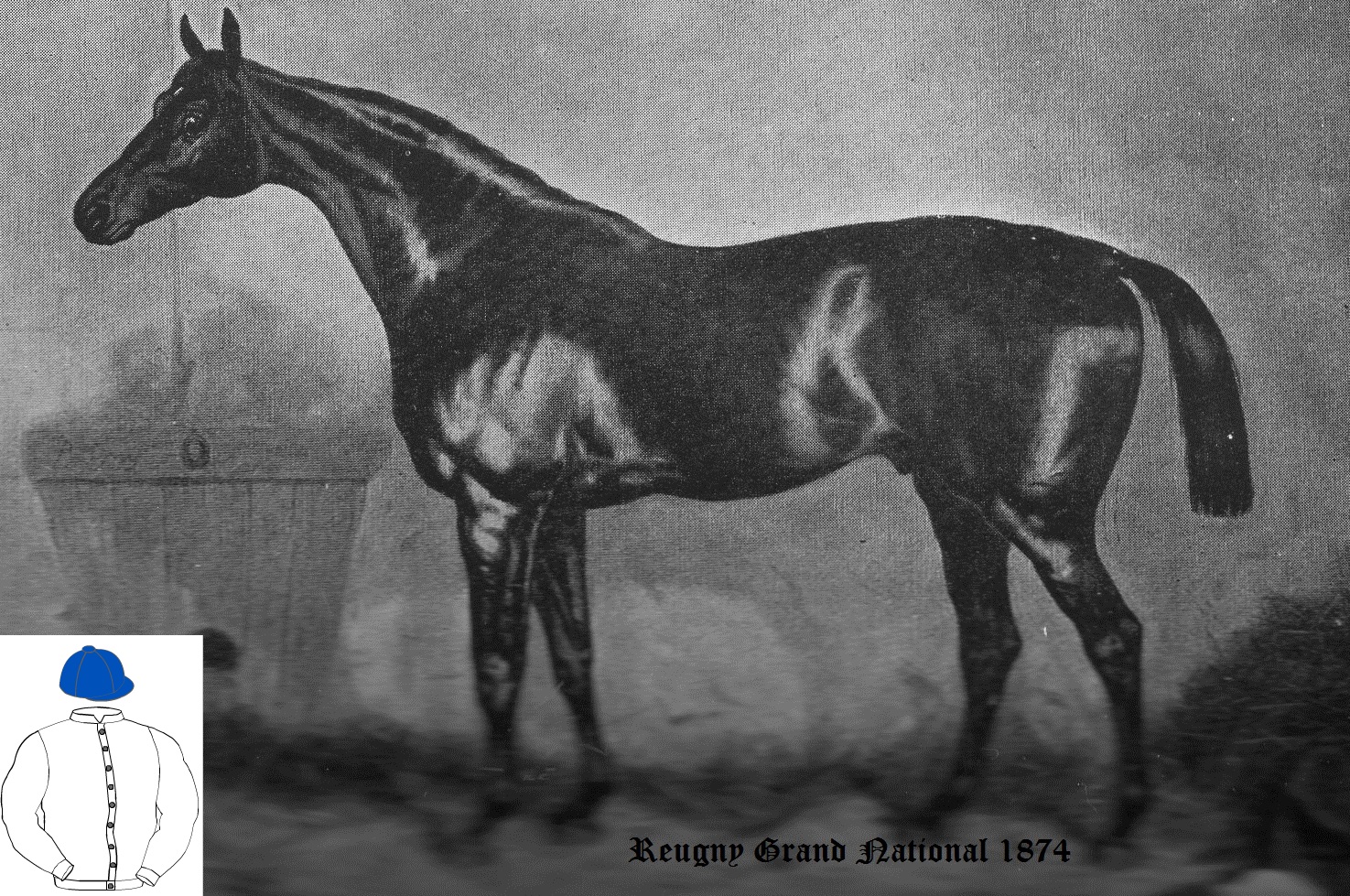
In the 1870s and 1880s Captain James Machell was responsible for 4 Aintree Grand National winners and the 1871 Scottish Grand National winner Keystone ridden by Mr J M Richardson. His first Grand National win was secured by Disturbance in 1873 when owned and trained by James Machell and ridden by Mr J M Richardson. The very next year he won the Grand National with Reugny, owned and trained by himself and ridden by Mr J M Richardson. The feat was repeated two years later when Regal, with Joe Cannon on board, won the 1876 Aintree Grand National. Finally, in 1882 the Grand National was won by Seaman owned and ridden by Lord Manners, but trained by James Machell.
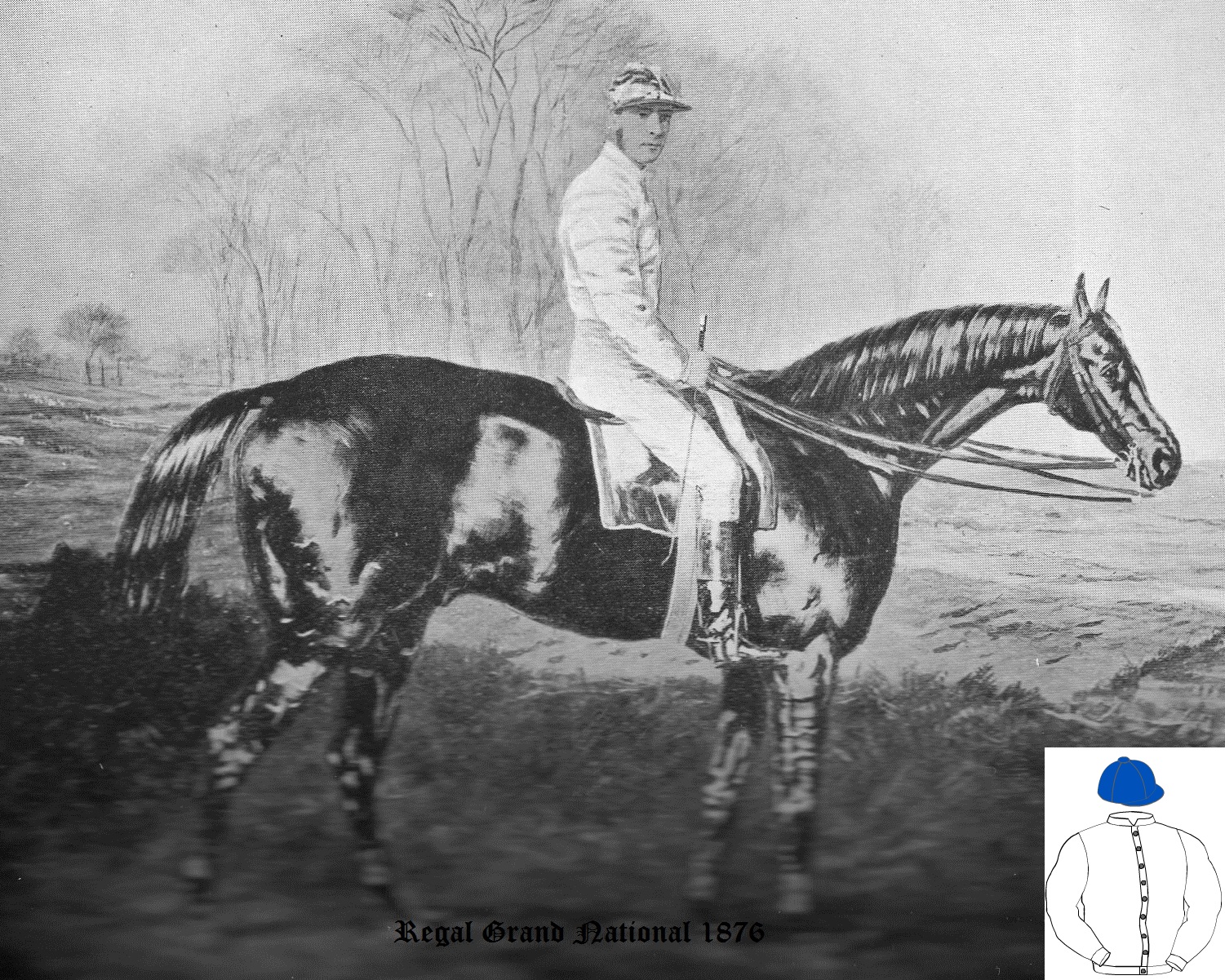

DISTURBANCE
One of Bedford House Stables most famous National Hunt horses in the later part of the 19th century was Disturbance, winner of the 1873 Grand National. The photos show a silver inkwell made from a hoof of Disturbance after its death, a memento of its famous victory. The inkwell is now owned by Andrew Stone, having previously been owned by his grandfather, Ernest Cecil Stone who was born in Lowestoft, but moved to York where he lived for most of his life. Ernest served in the Royal Navy during the Second World War before working for the GPO. It is unknown how he acquired the memento, particularly as he did not have a deep interest in horse racing. He was probably unaware that Disturbance had been a success on the Flat, as a steeplechaser and at stud. In 1872 Mr J M Richardson had ridden Disturbance to victory in a 6-furlong welter race at Ayr for owner James Barber, a professional racing man, and had been so impressed with the horse that he recommended that Captain James Machell purchase him for £500, which he duly did. Disturbance won the 1873 National at the first time of asking by 6 lengths at 20/1 for owner Captain James Machell when ridden again by J M Richardson. Machell is reported to have won £30,000 in bets on the victory, the equivalent today of £3.3 million. He was unfancied to follow-up in the 1874 Grand National when sent off at 100/1, finishing 6th behind stablemate Reugny who was also owned by Captain James Machell and ridden by J M Richardson. In 1875 Mr H Baltazzi purchased Disturbance for 1200 guineas despite the horse not having won a race for 2 1/2 years since his Grand National victory. Baltazzi declared him for the 1875 Leamington Grand Annual Steeplechase in November, but he failed to go to post in the race won by Congress. It seems that Disturbance was successful at stud however, his most famous son headed the funeral procession of the late Duke of Cambridge in March 1904 having been the Duke's hack for many years.


1873-1892 Captain James Machell, Joe Cannon & James Jewitt
Joe Cannon took charge on Tuesday 18th February 1873, succeeding the Bloss brothers at the Stables. This proved to be a successful period for James Machell and Joe Cannon, winning the Grand National on 3 occasions in the 1870s. In 1873 he won the Grand National with Disturbance (20/1) by 6 lengths when ridden by Mr J M Richardson, following up a year later with Reugny (5/1 fav) also winning by 6 lengths in the hands of Mr J M Richardson. In 1876 he owned Regal (25/1) who won the Grand National by a neck when ridden by Joe Cannon. Part way through the 1882 season Joe Cannon left Bedford Cottage to take up a post as trainer to the 5th Earl of Rosebery at Primrose Cottage Stables. Primrose Cottage Stables were demolished in 1974 to make way for building Fred Archer Way. James Jewitt assumed full control of the training duties at Bedford Cottage, his second spell in full charge.

In 1884 he bought Bedford Lodge Stables before leasing them to George Alexander Baird. Machell was victorious in the Epsom Derby on 2 further occasions; in 1884 Harvester (SR 1983) dead-heated at 100/7 with St Gatien (SR 2030), the former being owned by Sir John Willoughby and ridden by Sam Loates. Machell suffered from ill health and retired in 1892, handing over the training at Bedford House to James Jewitt who won the 1893 Derby with Isinglass (SR 2047) at 4/9 fav for Harry McCalmont when ridden by Tommy Loates. Captain James Machell was badly affected by the suicide of his great friend, the champion jockey Fred Archer who shot himself whilst in a state of delirium, probably as a result of taking pills to keep his weight down to a riding weight. Machell himself suffered a breakdown in late 1893, having sold Bedford Cottage Stables to Harry (Henry) McCalmont. However, prior to the start of the 1895 Irish Derby Machell purchased a half share in the smart colt Portmarnock (SR 2022) from Charles J Blake and Thomas L Plunkett. Although it was not trained at Bedford House, it proved to be an inspired purchase because the colt won at 2/5 favourite by an amazing 12 lengths when trained by Shem C Jeffery. James Octavius Machell suffered for many years from kidney stones and gout, being in constant pain for the last few years, dying on 11th May 1902 and is buried in Newmarket cemetery.
1873 Cesarewitch KING LUD owned by Lord Lonsdale, trained by Joe Cannon and ridden by T Bruckshaw
1875 Stewards Cup TRAPPIST owned by Captain Prime, trained by Joe Cannon and ridden by Fred Archer
1877 Dewhurst Stakes PILGRIMAGE owned by 4th Lord Lonsdale, trained by Joe Cannon and ridden by Harry Constable
1877 Ascot Gold Cup PETRARCH owned by the 4th Earl of Lonsdale, trained by Joe Cannon and ridden by Tom Cannon
1878 English 1000 & 2000 Guineas PILGRIMAGE (SR 1904) owned by the Earl of Lonsdale, trained by Joe Cannon and ridden by Tom Cannon
1878 Wokingham Stakes TRAPPIST owned by Captain Prime, trained by Joe Cannon and ridden by Fred Archer
1879 Royal Hunt Cup THE MANDARIN owned by Captain James Machell, trained by Joe Cannon and ridden by Charles Wood
1880 English 2000 Guineas PETRONEL (SR 1919) owned by the Duke of Beaufort, trained by Joe Cannon and ridden by George Fordham
1882 Royal Hunt Cup SWEETBREAD owned by Mr W Gerard, trained by James Jewitt and ridden by Jimmy Woodburn
1883 Royal Hunt Cup ELZEVIR owned by Mr W Gerard, trained by James Jewitt and ridden by Charles Wood
1883 Dewhurst Stakes QUEEN ADELAIDE owned by Sir John Willoughby, trained by James Jewitt and ridden by Fred Webb
1883 Epsom Oaks BONNY JEAN (SR 1845) owned by the Earl of Rosebery, trained by Joe Cannon and ridden by John Watts
1884 Epsom Derby HARVESTER (SR 1983) dead-heated with ST GATIEN (SR 2030) when owned by Sir John Willoughby, trained by Joe Cannon and ridden by Sam Loates
1884 Stewards Cup SWEETBREAD owned by Mr W Gerard, trained by James Jewitt and ridden by Tom Cannon
1886 Middle Park Stakes FLORENTINE owned by 5th Lord Calthorpe, trained by James Jewitt and ridden by John Watts
1886 Stewards Cup CRAFTON owned by Captain James Machell, trained by James Jewitt and ridden by Edwards
1887 St Leger KILWARLIN (SR 1921) owned by Lord Rodney, trained by James Jewitt and ridden by W T (Jack) Robinson
1887 Cesarewitch HUMEWOOD owned by Lord Rodney, trained by James Jewitt and ridden by Jack Robinson
1888 Royal Hunt Cup SHILLELAGH owned by Captain James Machell, trained by James Jewitt and ridden by George Chaloner
1888 Epsom Oaks & St Leger SEABREEZE (SR 2002) owned by Lord Calthorpe, trained by James Jewitt and ridden by W T (Jack) Robinson
1888 Ascot Gold Cup TIMOTHY owned by Mr Harry McCalmont, trained by James Jewitt and ridden by W T (Jack) Robinson
1889 Ascot Gold Cup TRAYLES owned by Mr W de La Rue, trained by James Jewitt and ridden by Jack Robinson
1889 Goodwood Cup TRAYLES owned by Mr W de La Rue, trained by James Jewitt and ridden by Jack Robinson
1891 Wokingham Stakes RATHBEAL owned by Captain James Machell, trained by James Jewitt and ridden by George Chaloner
At the 1888 Royal Ascot meeting Newmarket Stables won two-thirds of the first-place prize money, out-performing Lambourn stables and other prominent racing centres. Seven different Newmarket Stables provided winners, with James Jewitt leading the way with 4 victories.
James Jewitt
Coronation Stakes:-SEABREEZE (4/7 fav)
Gold Cup:-TIMOTHY (4/1)
Royal Hunt Cup:-SHILLELAGH (11/2 fav)
Queen Alexandra Stakes:-TIMOTHY (8/13 fav)
Mathew Dawson
Hardwicke Stakes:-MINTING (6/100 fav)
Jersey Stakes:-RADA (6/1)
Tom Jennings
King Edward VII Stakes:-SHEEN (7/4 fav)
Trial Plate (Queen Anne):-ZEST (20/1)
George Dawson
New Stakes (Norfolk Stakes):-DONOVAN (evens fav)
Fern Hill Stakes (Sandringham):-HAZLEHATCH (4/5 fav)
John Ryan
Triennial 1st Leg (Chesham Stakes):-REGALIA (100/14)
M Allen
Queen's Stand (King's Stand Stakes):-NOBLE CHIEFTAIN (4/6 fav)
Bob Sherwood
Gold Vase (Queen's Vase):-EXMOOR (100/30)
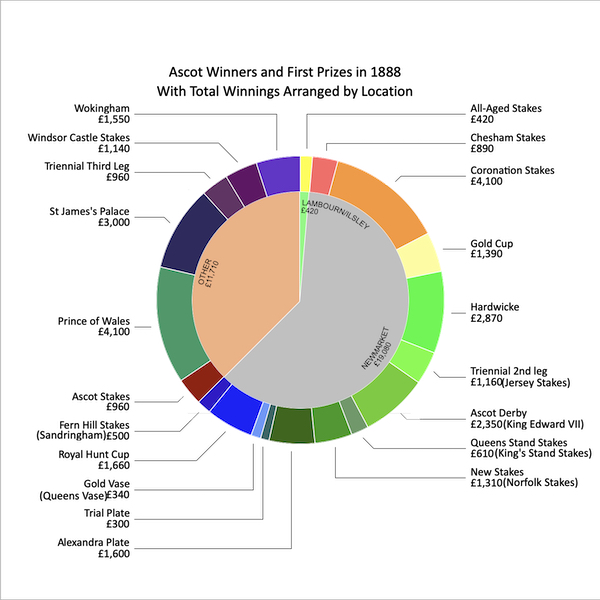
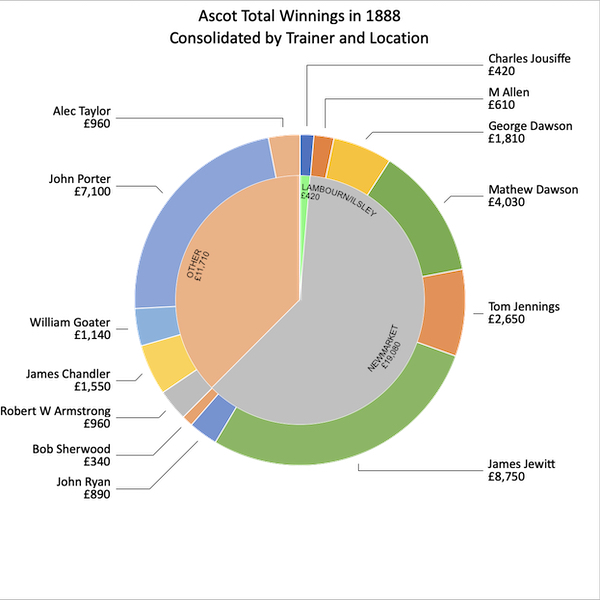
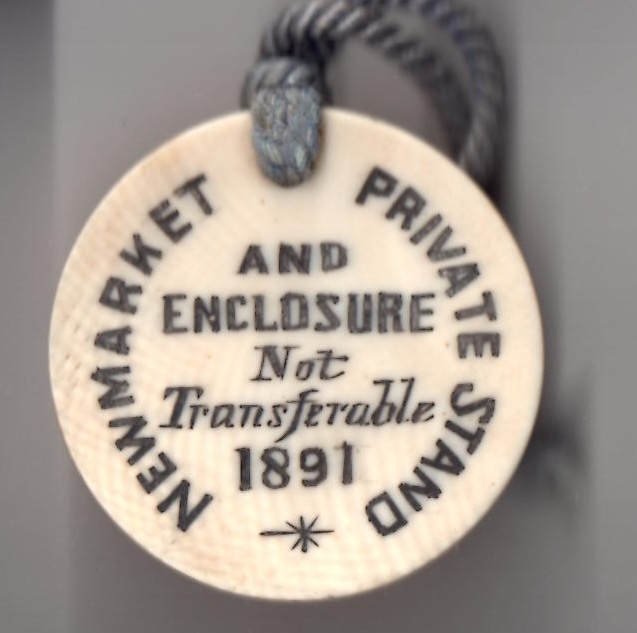
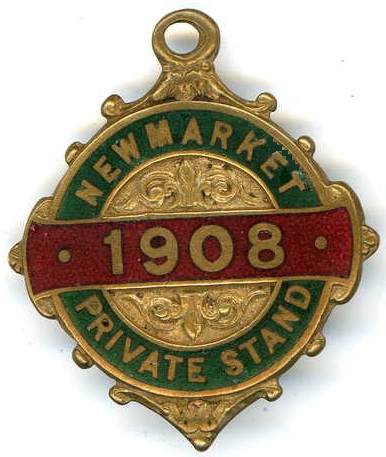

1892-1902 Colonel Harry McCalmont, Captain James Machell & James Jewitt, Major Beatty
In 1892 Colonel Henry McCalmont purchased Bedford Cottage Stables and Bedford House, winning the 1893 Derby and St Leger with Isinglass trained by James Jewitt and ridden by Tommy Loates. Two years later Isinglass won the Ascot Gold Cup in the hands of Tommy Loates. Jewitt was ill in November 1898, so Major Beatty replaced him
1892 Middle Park Stakes ISINGLASS owned by Mr Harry McCalmont, trained by James Jewitt and ridden by George Chaloner
1892 Royal Hunt Cup SUSPENDER owned by Mr Harry McCalmont, trained by James Jewitt and ridden by George Chaloner
1893 Epsom Derby & 2000 Guineas ISINGLASS (SR 2047) owned by Harry McCalmont, trained by James Jewitt and ridden by Tommy Loates
1893 Doncaster St Leger ISINGLASS (SR 2047) owned by Harry McCalmont, trained by James Jewitt and ridden by Tommy Loates
1894 Dewhurst Stakes RACONTEUR owned by Mr Harry McCalmont, trained by James Jewitt and ridden by Tommy Loates
1894 Eclipse Stakes ISINGLASS owned by Mr Harry McCalmont, trained by James Jewitt and ridden by Tommy Loates
1895 Chester Cup KILSALLAGHAN owned by Captain James Machell, trained by James Jewitt and ridden by Frederick Finlay
1895 Ascot Gold Cup ISINGLASS owned by Colonel Henry McCalmont, trained by James Jewitt and ridden by Tommy Loates
1895 Doncaster Gold Cup KILSALLAGHAN owned by Captain James Machell, trained by James Jewitt and ridden by Morny Cannon
1895 Cesarewitch ROCKDOVE owned by Mr C J Blake, trained by James Jewitt and ridden by C Ward
1897 Royal Hunt Cup KNIGHT OF THE THISTLE owned by Mr Harry McCalmont, trained by James Jewitt and ridden by Fred Allsopp
1897 Stewards Cup AMPHORA owned by Mr Harry McCalmont, trained by James Jewitt and ridden by Mornington Cannon
1898 Stewards Cup ALTESSE owned and trained by James Jewitt and ridden by Mornington Cannon
1901 Royal Hunt Cup STEALAWAY owned by Mr J B Leigh, trained by George Chaloner and ridden by Joe Childs
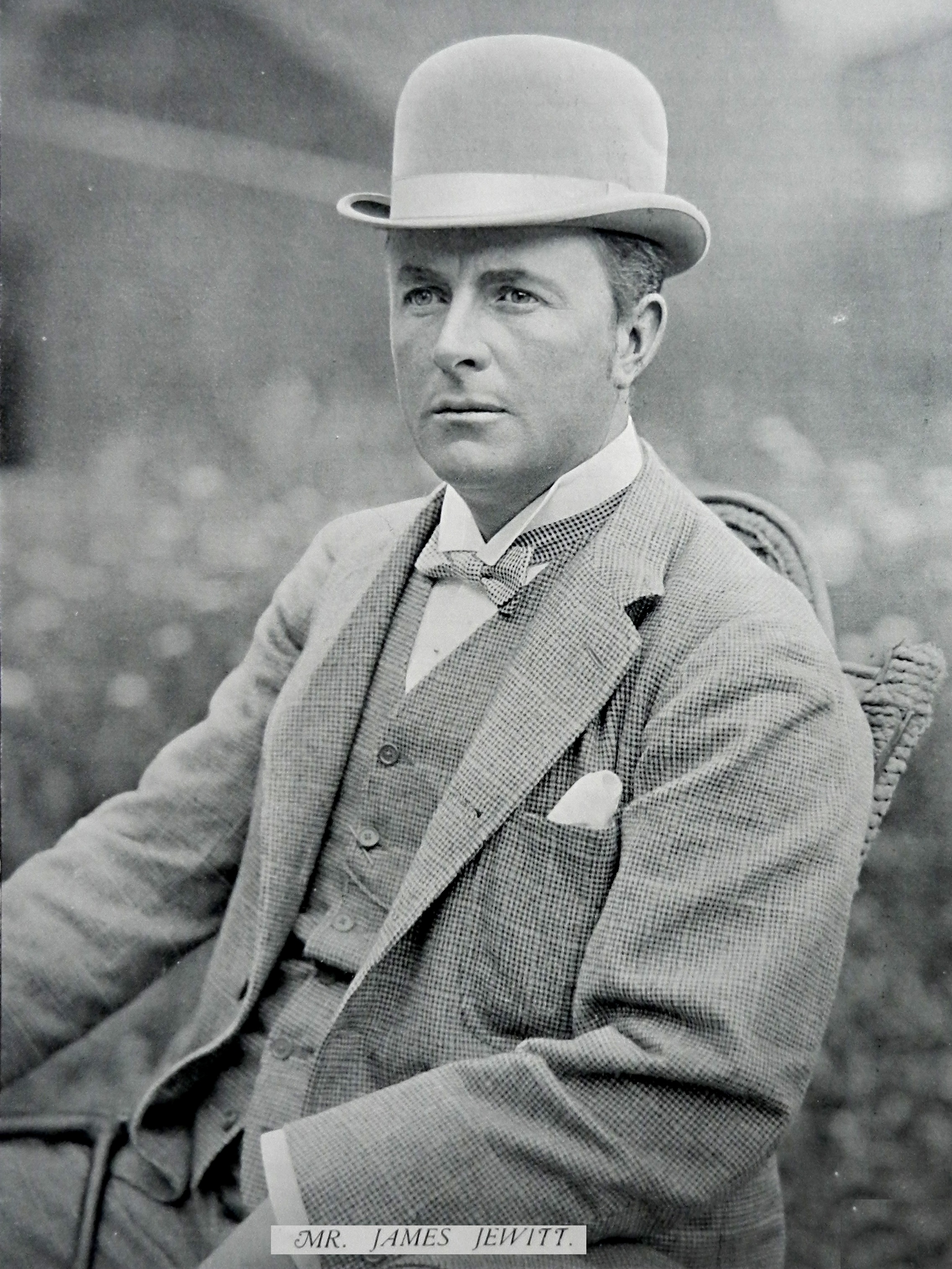
1902-1913 Lord Howard de Walden & Major Charles Beatty
After the death of Colonel Harry McCalmont, the Squire of Cheveley, Bedford House Stables were filled by horses belonging to a very wealthy nobleman and eligible bachelor, Lord Howard de Walden, who employed Major Charles Beatty as his trainer. Major Beatty had previously taken over as trainer for Colonel McCalmont when ill health forced James Jewitt to retire in November 1898, and Jewitt died on 11th November 1899. Charles Beatty, brother of Admiral of the Fleet Sir David Beatty of Jutland fame, was previously a well-known jockey before turning his hand to racehorse training. As a successful jockey he won the Grand International Steeplechase at Sandown in 1895 and came second in the Grand National in 1897. The most famous horse he trained was called Zinfandel. Lord Howard de Walden, Thomas Scott-Ellis, the 8th Baron de Walden, was born on 9th May 1880 and died on 5th November 1946, after which his first son, John Osmael Scott-Ellis became the 9th Lord Howard de Walden. He was a prominent racehorse owner on both the Flat and National Hunt racing scenes, owning the 1985 Derby winner Slip Anchor (SR 2106) and the Champion Hurdle winner Lanzarote. Major Beatty enjoyed good seasons and bad; in the 1908 Flat season he won just 9 races from his Bedford Cottage Stables, training for both Lord Howard de Walden and Captain R Sheriffe. However, in his good seasons Beatty trained winners of the Lincoln, Craven Stakes, Coronation Cup, Wokingham, Ascot Derby, Manchester November Handicap, Manchester Cup, Ascot Gold Vase, Gordon Stakes, Jockey Club Stakes and Brighton Cup. After leaving Bedford House at the end of the 1913 season, when his lease expired, Beatty made his home at Atherstone in Warwickshire but was recalled to the colours in 1914 at the start of the First World War. He was ADC to the General officer commanding the Canadian Expeditionary Force, was mentioned in despatches, and severely wounded at St Eloi in April 1916. Major Beatty lost an arm and for a time was comparatively active, but died after a third operation arising out of his wounds in a nursing home off Cavendish Square on 17 May 1917. He was buried at Atherstone with full military honours at the same time as a memorial service was held at St Agnes's, Exning. He left a widow and a young son.
1902 Lincoln Handicap at Lincoln ST MACLOU 100/8 owned by Colonel H McCalmont, trained by Major Beatty and ridden by G McCall
1903 Wokingham Handicap at Royal Ascot GLASS JUG 20/1 owned by 8th Baron Howard de Walden, trained by Major Charles Beatty and ridden by Miller
1903 Ascot Gold Vase at Royal Ascot ZINFANDEL 11/10 fav owned by 8th Baron Howard de Walden, trained by Major Charles Beatty and ridden by Morny Cannon
1903 Gordon Stakes at Glorious Goodwood ZINFANDEL 2/5 fav owned by 8th Baron Howard de Walden, trained by Major Charles Beatty and ridden by Morny Cannon
1904 Coronation Cup at Epsom ZINFANDEL 9/2 owned by 8th Baron Howard de Walden, trained by Major Charles Beatty and ridden by Morny Cannon
1905 Ascot Gold Cup ZINFANDEL 2/5 fav owned by 8th Baron Howard de Walden, trained by Major Charles Beatty and ridden by Morny Cannon
1906 Ascot Derby (King Edward VII Stakes) POUSSIN 11/10 fav owned by 8th Baron Howard de Walden, trained by Major Charles Beatty and ridden by W Higgs
1911-1915 Honourable Francis Lambton
In the years leading up to the start of the First World War the Honourable Francis Lambton was named as trainer at Bedford House Stables. He joined the Royal Horse Guards (The Blues) and was killed in action on Tuesday 31st October 1916.
1916-1920 Frederick Charles Paine
In the years immediately following the end of the First World War Frederick Charles Paine was named as trainer at Bedford House Stables.

1920-1928 Captain Percy Bewicke
In 1909 Captain Percy Bewicke applied for a licence to train racehorses, learning his trade in Wiltshire before taking over at Bedford House Stables. In March 1928 the Estate Agent Mr O E Griffiths was instructed by Captain Percy W Bewicke to sell by auction on Monday 2nd April 1928 racing stable equipment, saddlery and horse clothing from Bedford House Stables. By February 1929 Bedford House, and the adjoining stables, was sold by Captain Percy Bewicke to Jack Clayton, son of Mrs Clayton of Severalls House, Newmarket for £15,000.
1929-1936 Jack Clayton, J H S Cannon, Noel Cannon
Jack Clayton purchased Bedford House from Captain Percy Bewicke and installed James Herbert Sharp Cannon as trainer. It was the ideal site for him, adjacent to his mother's stables at Severalls House. From Spring 1933 to 1935 Noel Cannon replaced his brother, but was then offered the post of private trainer to James V Rank at Druids Lodge.
1936-1938 Honourable H G Wellesley
In January 1938 the Honourable H G Wellesley transferred his training establishment from Bedford House Stables, where he had been between 1936 and 1938, to Osborn Lodge at The Curragh.
1938 Goodwood Cup & Doncaster Cup EPIGRAM owned by James V Rank, trained by Noel Cannon and ridden by Brownie Carslake
1939-1945 Sir Victor Sassoon & Jack Payne
In 1939 Sir Victor Sassoon moved some of his horses to Bedford House Stables to be trained by Jack Payne, beginning a successful partnership which was to last for just 6 years. Sir Victor began moving some of his horses from Bedford Lodge in 1944, and speeded up the process in 1945 when Jack Payne, aged only 57, suffered a heart attack while riding his hack on Newmarket Heath on Tuesday 13th November 1945. Jack Clayton later became Racing manager to Sir Victor Sassoon.
1946-1975 Sir Victor Sassoon/Willie Pratt/ Norman Bertie/Jack Clayton
In October 1945 it was announced that Willie Pratt, who rode and trained numerous winners in France before 1940, would take over the training of Sir Victor Sassoon's horses at Bedford House Stables for the 1946 Flat season. Willie was one of 7 brothers born to a sister of the late, great jockey Fred Archer. In 1952 Jack Clayton took out his training licence, assisting Norman Bertie at Bedford House Stables. The dual partnership also had an interest in Green Lodge Stables, although it is uncertain whether they kept horses stabled there on a regular basis. However, it was Norman Bertie who was credited with training the famous 1953 Epsom Derby winner Pinza (SR 2131) for Sir Victor Sassoon. In September 1953 Sir Victor Sassoon moved his horses from Bedford House Stables despite his Epsom Derby success. Jack Clayton later took out a Trainer's Licence in his own name in 1962, and died in 1975 aged 72, while Sir Victor Sassoon died on 13th August 1961. Bedford House stables was offered for sale in April 1975 and was bought be the former Italian amateur jockey Luca Cumani who had moved into Bedford House by October 1975.

1948 Goodwood Cup TENERANI owned by Federico Tesio, trained by Norman Bertie and ridden by Enzo Camici
1948 Yorkshire Cup WHITEWAY trained by Norman Bertie and ridden by Bill Evans
1952 Dewhurst Stakes PINZA evens fav owned by Sir Victor Sassoon, trained by Norman Bertie and ridden by Gordon Richards
1953 Epsom Derby PINZA (SR 2131) 5/1 jt fav owned by Sir Victor Sassoon, trained by Norman Bertie and ridden by Gordon Richards
1953 Newmarket Stakes PINZA 3/1 owned by Sir Victor Sassoon, trained by Norman Bertie and ridden by Gordon Richards
1953 King George VI & Queen Elizabeth Stakes PINZA 2/1 owned by Sir Victor Sassoon, trained by Norman Bertie and ridden by Gordon Richards
1962 Doncaster Gold Cup BONNARD owned by Marchese della Rochetta, trained by Jack Clayton and ridden by Ron Hutchinson
October 1975-2018 Luca Cumani
Luca Cumani, champion amateur rider in Italy in 1972, took over at Bedford House Stables in 1976, enjoying a wonderful first season, the highlights of which were Konafa's second place to Flying Water in the 1976 1000 Guineas, and the title of leading trainer at home track Newmarket with 11 winners spread across the Rowley Mile and July courses. The son of successful Italian trainer Sergio Cumani had spent the previous two years as assistant to Henry Cecil prior to moving to Bedford House Stables. In 1977 he trained Freeze The Secret to be runner-up to Mrs McArdy in the 1000 Guineas before finishing second to HM The Queen's Dunfermline in the Epsom Oaks, while Cumani's other filly Vaguely Deb finished third. In 1983 Cumani began making a name for himself abroad, capturing the Arlington Million with Tolomeo. In 1984 Luca Cumani sent out Commanche Run (SR 2055) to land the Doncaster St Leger Stakes by a neck from Baynoun when 7/4 favourite, the winner being owned by Ivan Allan and ridden by Lester Piggott. In the 1986 season Luca achieved his highest number of winners to that point, 67 in a season, and was rewarded with a contract to train 15 two year olds for the Aga Khan the next season. Just two years later Luca achieved a highlight of his career, winning the Epsom Derby and Irish Derby with Kahyasi (SR 1975). Between 1976 and 1990 Luca could assess his career as a success, but in 1990 he hit a serious setback when HH Aga Khan withdrew all his horses from British Racing following the disqualification of his Oaks winner Aliysa. Although the Aga Khan's horses were spread across a small number of stables, Luca was hit hardest, losing a quarter of his stable stars. It was to be a further six years before the Aga Khan returned to British racing, lifting Cumani's stable number to 140. However, during the difficult period without the Aga Khan's support Luca Cumani sent out the 1994 Breeders Cup winner Barathea from his Bedford House Stables.
In October 1997 a second fire within 24 hours at Luca Cumani's Bedford House Stables was put out by 40 firefighters. Fifty firefighters had attended the same stables the day before to extinguish a large fire. Fortunately none of the 120 horses was hurt, although the L-shaped roof on the Victorian Stable block was severely damaged. Luca recovered well from the setback and in 1998 reached another pinnacle in his illustrious career, training High Rise (SR 1976) to success in the Epsom Derby when ridden by Olivier Peslier. Moving on a decade, Bedford House was granted Listed status on 30th October 2006.
1983 Arlington Million TOLOMEO owned by Carlo d'Alessio, trained by Luca Cumani and ridden by Pat Eddery
1984 Doncaster St Leger Stakes COMMANCHE RUN (SR 2045) owned by Ivan Allan, trained by Luca Cumani and ridden by Lester Piggott
1986 Yorkshire Cup EASTERN MYSTIC trained by Luca Cumani and ridden by Pat Eddery
1988 Epsom Derby KAHYASI (SR 1975) owned by HH Aga Khan, trained by Luca Cumani and ridden by Ray Cochrane
1988 Irish Derby KAHYASI (SR 1975) owned by HH Aga Khan, trained by Luca Cumani and ridden by Ray Cochrane
1989 Irish 1000 Guineas ENSCONSE (SR 1860) owned by Sheikh Mohammed, trained by Luca Cumani and ridden by Ray Cochrane
1991 Yorkshire Cup ARZANNI trained by Luca Cumani and ridden by Frankie Detorri
1993 Irish 2000 Guineas BARATHEA owned by Sheikh Mohammed, trained by Luca Cumani and ridden by Ray Cochrane
1993 Yorkshire Oaks ONLY ROYALE owned by Giuseppe Sainaghi, trained by Luca Cumani and ridden by Ray Cochrane
1994 Yorkshire Oaks ONLY ROYALE owned by Giuseppe Sainaghi, trained by Luca Cumani and ridden by Frankie Detorri
1994 Breeders Cup Mile BARATHEA owned jointly by Sheikh Mohammed and Gerald Leigh, trained by Luca Cumani and ridden by Frankie Detorri
1998 Epsom Derby HIGH RISE (SR 1976) owned by Sheikh Mohammed Obaid Al Maktoum, trained by Luca Cumani and ridden by Olivier Peslier
2002 Irish 1000 Guineas GOSSAMER (SR 1853) owned by Gerald Leigh, trained by Luca Cumani and ridden by Jamie Spencer
2002 Doncaster Gold Cup BOREAS owned by Aston House Stud, trained by Luca Cumani and ridden by Jamie Spencer
2019-present Charlie Fellowes
Charles Henry Fellowes, born 1986, is the son of John Ailwyn Fellowes and Alison Birkmyre, Lord and Lady de Ramsey, whose estate is at Abbots Ripton Hall near Huntingdon. Although Lord de Ramsey was not a frequent racegoer, Charlie's mother owned shares in a racehorse which provided Charlie with the opportunity to attend the local races at Newmarket. Charlie was educated at Leeds University before spending time learning his trade from James Fanshawe. Charlie, who is married to Victoria and has a young son Jack, launched his training career in early 2014 at Saffron House Stables, but in July 2014 he moved to St Gatien Stables. Prince of Arran and Chiefofchiefs provided him with some early wins as a trainer. When Luca Cumani announced his retirement in 2019, Charlie purchased the historic 120-box Bedford House Stables.
2019 32Red.com Handicap at Kempton CHIEFOFCHIEFS 3/1 owned by Mr Mervyn Ayers, trained by Charlie Fellowes and ridden by Richard Kingscote
2019 Dubai Duty Free Conditions Stakes at Newbury KING OTTOKAR 14/1 owned by Mrs Susan Roy, trained by Charlie Fellowes and ridden by Ben Curtis
2019 Rockton Fillies Nursery at Newcastle ONASSIS 15/8 owned by Triermore Stud & Hon P Stanley, trained by Charlie Fellowes and ridden by Hayley Turner
2020 Sandringham Stakes at Royal Ascot ONASSIS 33/1 owned by Triermore Stud & Hon P Stanley, trained by Charlie Fellowes and ridden by Hayley Turner
2020 Silver Wokingham Handicap at Royal Ascot CHIEFOFCHIEFS 20/1 owned by Mr Mervyn Ayers, trained by Charlie Fellowes and ridden by William Buick
2020 Prix De Bagatelle at Chantilly ONASSIS 13/2 owned by Triermore Stud & Hon P Stanley, trained by Charlie Fellowes and ridden by Hayley Turner
PINZA (1953 Epsom Derby, King George Vi & Queen Elizabeth Stakes, 1952 Dewhurst Stakes)
ISINGLASS (1893 Triple Crown)
COMMANCHE RUN (1984 St Leger)
HERMIT(1867 Epsom Derby)
SEABREEZE (1888 Epsom Oaks, St Leger)



